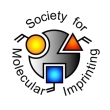Authors: Sun GY, Zhong DD, Li XJ, Luo YQ, Ba H, Liu ZS, Aisa HA
Article Title: Effect of minimizing amount of template by addition of macromolecular crowding agent on preparation of molecularly imprinted monolith.
Publication date: 2015
Journal: Analytical and Bioanalytical Chemistry
Page numbers: 1-12.
DOI: 10.1007/s00216-015-8902-0
Abstract: One of the main challenges in the preparation of molecularly imprinted polymers (MIPs) is the substantial initial amount of template needed because of the requirement of high load capacities for most applications. A new strategy of macromolecular crowding was suggested to solve this problem by reducing the amount of template in the polymerization recipe. In a ternary porogenic system of polystyrene (PS) (crowding agent), tetrahydrofuran, and toluene, an imprinted monolithic column with high porosity and good permeability was synthesized using a mixture of ellagic acid (template), acrylamide, and ethylene glycol dimethacrylate. The effect of polymerization factors, including monomer-template molar ratio and the molecular weight and concentration of PS, on the imprinting effect of the resulting MIP monoliths was systematically investigated. At a high ratio of monomer-template (120:1), the greatest imprinting factor of 32.4 was obtained on the MIP monolith with the aid of macromolecular crowding agent. The PS-based imprinted monolith had imprinting even at the extremely high ratio of functional monomer to template of 1510:1. Furthermore, an off-line solid-phase extraction based on the ground MIP was conducted, and the purification recovery of ellagic acid from pomegranate-rind extract was up to 80 %. In conclusion, this approach based on macromolecular crowding is simple, and is especially valuable for those applications of MIP preparation for which a rare template is used
Author keywords: Monolith, Molecularly imprinted polymer, Polystyrene, Ellagic acid, Macromolecular crowding agent



Join the Society for Molecular Imprinting

New items RSS feed
Sign-up for e-mail updates:
Choose between receiving an occasional newsletter or more frequent e-mail alerts.
Click here to go to the sign-up page.
Is your name elemental or peptidic? Enter your name and find out by clicking either of the buttons below!
Other products you may like:
 MIPdatabase
MIPdatabase









